
Rollator Walker
Recommendations and A Buying Guide
A rollator walker (also called four wheel walker or 4WW) is an excellent mobility product that reduces the risk of falling for many seniors.
The basic design includes four wheels, brakes (much like a bicycle), a seat and a bag (or basket) to carry items in.
Most can be folded up to put in the trunk of a car.
Maybe you've noticed that your loved one is having to hold onto furniture or the walls while walking around the home.
Or worse, they had a recent fall.
A rollator walker is easy to use and has many benefits - provides balance support, a place to sit when tired and a place to carry items.
Read more below to determine if it would be useful for the elderly person in your life.
Overview
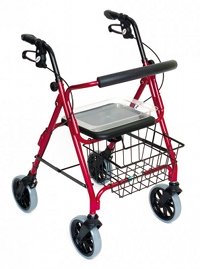
A rollator walker (also called four wheel walker, rolling walker or walker with seat) is a common mobility aid for elderly.
The two front wheels swivel (similar to a grocery/shopping cart) and the rear wheels are fixed. There are two hand brakes that work like bicycle brakes as well as have a locking feature by pushing the levers down.
Locking brakes are great for making sure the rollator walker does not roll away when the seniors is getting up/down from a chair or while their trying to sit on the walker.
They have many benefits besides providing support for decreased balance, strength and endurance.
Many seniors tire easily and find it helpful to have a place to sit down when they need a break at the mall or on the sidewalk. Others enjoy the ability to carry items in their walker rather than in a bag or purse.
They are also very easy to use and most seniors prefer them over other types of walkers for elderly.
Who Should Use?
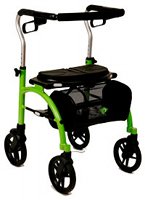
A rollator walker is excellent for elderly with mild to moderate issues with balance, strength or endurance.
Elderly often start using them after they have had a fall but I encourage the elderly to use them before they have a fall as a way to prevent injury. The last thing anyone wants is a hip fracture!
They are also perfect for elderly who want:
- A place to sit down when they are tired
- A place to carry items safely and not in bags over their shoulder
- Peace of mind and confidence that a rollator walker provides - especially for seniors who have a fear of falling
Who Should NOT Use?
There are a few instances where a senior should not use a rollator walker:
- Seniors that need to keep weight off a leg/foot after surgery or a fracture should use a folding walker.
- Elderly that cannot safely stand - either due to balance, strength and/or endurance. They should obviously consult with their family doctor and would be more suitable for a light weight wheelchair.
Recommended Features
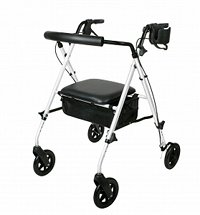
A rollator walker should have the following features:
- Solid construction - All four wheels should touch the floor on level ground.
- Lightweight - So seniors or their friends and family can put it in the trunk of a car.
- Basket/bag - To carry items as the users hands will be busy.
- Basket style - Solid baskets can be attached on the front of some walker styles. Cloth baskets are built in and fold with walkers in other styles.
- Cushioned seat with backrest - This is a nice feature as some models are not comfortable to sit on.
- Big Wheels - 8" or taller as they tend to roll easier over uneven ground.
- Size - Generally, the bigger the person, the bigger the walker. However, make sure it can be used inside (ie. fit through the users hallways and doorways).
- Weight capacity - Make sure the walker can support their weight.
- How they fold - Some fold front to back and others side to side. Choose according to personal preference.
Walker Accessories
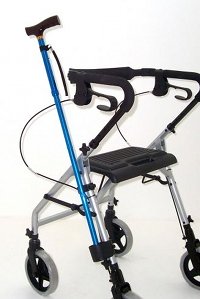
There are a number of accessories that elderly should consider:
- Oxygen tank holders - This is a must have for seniors who need to use oxygen. Most baskets/bags are not designed to hold oxygen tanks securely.
- Bags/baskets - There are additional bags/baskets that can be added to the walker. I recommend keeping the weight low to the ground to prevent them from tipping over.
- Cane holders - Some seniors like to have a cane close by for areas where they cannot take their walker - such as a small bathroom or dining room.
- Seat cushion - Some of the seats are not comfortable.
- Lights - So that people can see them at night.
- Reacher holders - A handy feature that allows easy access to a reacher to pick items up from the floor.
- Reflectors - For safety, especially in the evening.
- Bottle holders - To carry water or coffee as the users hands will be busy when walking.
- Roll resistors - Provides resistance to the rear wheels so that the walker can be slowed down.
- Skis for front wheels - For winter conditions when the front wheels have difficulty rolling. I recommend staying inside as if there is snow, it will likely be slippery and its not worth the risk of falling.
For more information: Walker Accessories
How to Fit
Similar to other mobility products for the elderly, the basic rule is to adjust the handles to the same height as the seniors wrist.
How to measure:
- Have the senior put their regular shoes on
- Have them stand next to the wall or a chair for support
- Have them stand tall and put one arm at their side
- Measure from the ground to the crease of their wrist
- Make sure the walker can adjust to this height (and up/down at least 1 inch to allow for some adjustability)
How to Use
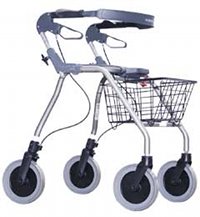
A rollator walker is very easy to use:
- Become familiar with the walkers brakes - similar to a bicycles brakes but they also lock by pushing down on the levers.
- With them locked, get up from a chair/couch.
- Once standing, squeeze the brake levers to release.
- Hold onto the handles, stand tall and walk like normal.
- The senior should be walking within the walker and not have it too close or far away - this depends on the height of the user.
- When they want to sit down on the walker, they push the levers down to lock the wheels, turn around, reach for the handles and sit.
- When they want to sit down in a chair/bed/couch, they turn around till the chair/bed touches the back of the legs, push the brake levers down to lock the wheels and sit down.
How Much Do They Cost?
A rollator walker costs between $100 to $600.
It's like buying a car. The more expensive models are higher quality and will last longer. Compare a less expensive model to a more expensive model and you will notice that they roll differently, the grips may be more (or less) comfortable, they are sturdier, lighter weight and replacement parts are available. The cheaper models do not have replacement parts, do not last as long and are not as enjoyable to use.
Other Types of Walkers
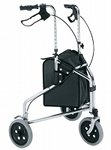
There are a variety of other walkers, including:
- Folding walker - Standard walker with 4 legs and no wheels.
- Front wheel walker - Standard walker with two wheels and two legs/skis.
- 3 wheel walkers - 3 wheels, bag/basket, no seat and hand brakes.
- Knee walker - Wheeled specialized walker for seniors with leg/foot surgery or fracture.
- U-Step walker - Wheeled specialized walker for elderly with Parkinson's Disease.
Return to Mobility Products for the Elderly
Return to Equipment for Seniors
Return to Caring for Aging Parents


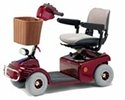



New! Comments
Have your say about what you just read! Leave me a comment in the box below.